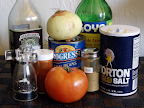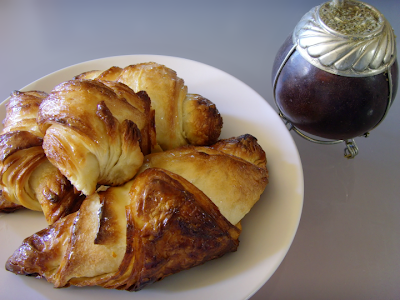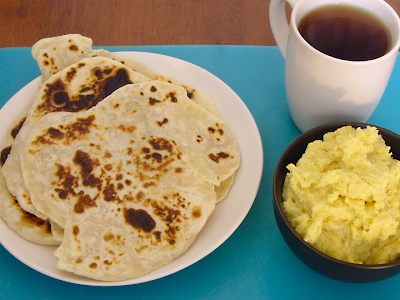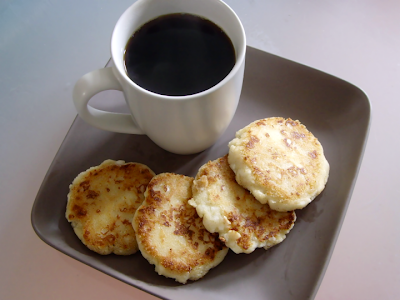Sunday, November 28, 2010
Argentina - Medialunas and Yerba Mate
Background
Argentine cuisine is a blend of French, Spanish, Italian, and Andean influences. This split of European and native influences is found in the differences between the cities and rural areas.
I found lots of information on Argentine cuisine is and its regional variations. All of the books basically mention breakfast as “minimal,” which I interpret as very simple. Looking online I learned that breakfast is either bread covered with dulce de leche, or medialunas, a croissant-shaped pastry. I chose to make medialunas because I wanted to try a variation on the croissant. The drink is either cafe con leche or a tea made from the leaves of the yerba mate plant called mate. Yerba mate is traditionally served from a hollowed gourd, which we conveniently had in the apartment.
Recipe
For this weeks recipe we refer you to the blog of an American ex-patriate living in Necochea, Argentina, who did a wonderful job describing the process. I had to make a substitution for the yeast. Her recipe uses 0.9 oz of fresh yeast which expires quickly because the yeast is active when purchased. We do not bake enough to keep this on hand so I used a substitution of 1½ packages of active dry yeast. Another issue created by this substitution is the need of warm water to activate the yeast. I heated up the milk used in the recipe to serve this purpose. We also chose to put the vanilla extract in the glaze and not in the dough.
Yerba Mate Video
Results and Discussion
The medialunas came out great despite some reservations about the dough I will discuss later. They smelled fantastic while baking and bled butter as they puffed and browned. The vanilla sugar glaze added a nice texture and sweetness. While they were flaky on the outside, the inside felt meatier and solid—a nice contrast.
I was not a fan of the yerba mate. It was bitter and very overpowering. The taste changed with each sip as continued to steep and preferred the earlier sips to the later ones. In the second brewing of the leaves the bitterness was greatly reduced but still pretty strong. Some people add sugar to help with this problem but we were drinking it out of a gourd my mother-in-law gave my wife after her trip to Argentina and putting sugar into these is ill-advised. I should also mention that the bombilla conducts heat so sip carefully if it has been sitting in the water for a long time.
I was initially concerned because the dough was very dry. I checked this against the croissant recipe we used for France and based on the ratios the dryness seemed reasonable. With a dryer dough, cold rising, and my impatience to let the dough get up to room temperature, working the dough was difficult. Kitty came up with a good solution to this on the final turn and I wrapped the dough in a damp warm rag for 10 minutes. Letting the dough rest for an hour outside the fridge in the morning reduced this problem.
I was also nagged by a feeling that the yeast had not fully activated and that this inhibited the rising. I saw the yeast bubbling in the milk before I added it to the mixture so I know it activated.
I would also like to compare the writing of the recipe in this breakfast to the French croissant. This recipe was much more free form in its approach giving the essential guidelines but allowing the cook to shape and size the final item. The French recipe was much more highly detailed with exact dimensions and more information about resting times and other details. It was a gift to a cook trying something intimidating for the first time. The medialunas recipe was great for a second pass at this type of pastry because more awareness of basic techniques are placed on the cook. It demonstrates the importance of understanding why something is done versus following instructions.
Labels:
beverages,
pastry,
South America
Sunday, November 21, 2010
Tanzania - Ugali and Chapati
Background
Tanzania was founded in 1964 when the states of Tanganyika and Zanzibar merged. Zanzibar consisted of two islands off the eastern coast and Tanganyika was on the mainland. Zanzibar has a history as a trading port which gave it contact with cultures from all over the Indian Ocean. Its major assets were spices and slaves. Zanzibar's cuisine is based around rice, and coconut and seems very similar to Indian food. The mainland diet is based around bean, cassava, and corn which is closer to its neighbors.
 I was surprised when I came across Tanzania Traditional Cookery in the library. It is basically a pamphlet bound in card-stock. The pages are inconsistently photocopied and the table of contents is only a rough guide on where to find the recipes. It also provided an entire section of breakfast food. Upon further examination all of the meals were listed under breakfast. This made me doubt the credibility of the categories given.
I was surprised when I came across Tanzania Traditional Cookery in the library. It is basically a pamphlet bound in card-stock. The pages are inconsistently photocopied and the table of contents is only a rough guide on where to find the recipes. It also provided an entire section of breakfast food. Upon further examination all of the meals were listed under breakfast. This made me doubt the credibility of the categories given.The second book we found was Tanzania Cookbook which had a far more credible table of contents. It fails to provide any information about when the dishes are usually served or the cultural heritage of the dishes. What makes this even stranger is that the blurb on the back of the book says that the book is for educational purposes. One of the major annoyances I have encountered in this project is books that purport to extol the virtues of a country's cuisine but give no cultural context about the dishes.
Given the absence of contextual and cultural information I went to the Internet. The Tanzanian Embassy webpage provided us with contextual information and a list of breakfast dishes. Once we had a list of dishes the cookbooks became useful.
We decided to go with ugali and chapatis served with chai tea. Ugali is a corn porridge that was compared to polenta in many recipes that I read. The chapatis use coconut milk which is different from past recipes.
Coconut Chapatis
- Mix flour and salt in a bowl.
- Add coconut milk and mix until it is doughy. Slowly add more coconut milk if required.
- Add ½ tablespoon of ghee to the dough and knead until it is smooth.
- Divide the dough into 6 evenly sized balls.
- Roll out a ball into a large flat circle.
- Cover circle with ½ tsp of ghee/oil.
- Make a slit along the radius of the dough and roll it into a cone.
- Seal the edges of the cone and squash it flat.
- Let them rest for 20 minutes.
- Heat a non-stick pan.
- Roll out the dough flat until it is about 1//8 of an inch thick.
- Melt some ghee in the pan put the flattened dough into the heated pan.
- As the uncooked side starts to puff spread some ghee and flip it.
Ugali
- 120 g fine corn meal
- ½ cup milk
- ½ cup water
- ½ tbsp butter (optional)
- salt (optional)
- Make a paste with the corn meal and milk.
- Bring the water to a boil, add the butter and salt.
- Stir in paste and then add the remaining maize flour.
- Continue to stir until it becomes stiff.
- Serve on top of warm chapatis.
Results and Discussion
The coconut milk in the chapatis gave the dough a much softer texture than previous recipes we had used. The layering technique used in making them gave them a flaky texture and the oil kept them very soft.
The ugali was very simple and a little bland. We also think it might have been under done. We halved the recipe from the one given in the cookbook and quantity of water and milk may have been too small to properly cook it. Another problem might have been our choice of corn meal. The recipe called for maize flour which according to my research is corn meal. Many recipes for ugali compare it to polenta for its texture. Fine corn flour may be too fine for our needs and using polenta might be a better substitute in the future.
Labels:
cereal,
East Africa,
things on toast
Sunday, November 14, 2010
Sudan - Fool Medamas
Background
The history of Sudan is closely linked to Egypt's. Both countries have conquered one another and both were under British and Ottoman rule. I had difficulty finding a published source on the Sudan and in the end I decided to use the web site Sudan.net. This site listed fool medamas and tamayya as possible breakfasts. We made fool medamas as our breakfast for Egypt, though we spelled it differently. Tamayya is another word for falafel and it is eaten at any time of the day.
After we made our Egyptian breakfast I ran across an article in the paper listing the best dishes in Boston. One of these dishes was the fool medamas from Falafel Palace. We were not very thrilled with our recipe so I wanted to try a much different version. Falafel Palace makes a great version more like a bean salad with fresh vegetables and a yogurt dressing. It made a great light lunch and is really cheap. The new recipe is very different than the one we used for Egypt so I decided we should do a comparison.
Fool Medamas
- 1 (16 oz) can of fava beans
- 1 large onion, chopped
- 1 large tomato, diced
- 1½ tbsp olive oil
- 1 tsp ground cumin
- ¼ cup chopped parsley,
- 4 tbsp lemon juice
- salt, pepper, and chili powder to taste
- pita bread

- Pour fava beans and juice into a sauce pan and bring them to a boil.
- Mix all other ingredients—except lemon juice—in a bowl.
- When the bean juice has almost evaporated add the remaining ingredients to the pot along with the lemon juice.
- Cook uncovered for about 5 minutes, until most of the water is gone but the mixture is not dry.
- Eat with pita bread along with hard boiled eggs and tahini.
This recipes was much better than the one we used for Egypt. The first major improvement was the inclusion of spices so that I actually tasted something. Not mashing the fava beans was also key. When the beans are mashed they suck up all the moisture and the result is a very dry paste with some vegetables mixed into it. Not mashing the beans keeps the fool medamas moist and much more palatable.
Labels:
beans,
North Africa,
things on toast
Sunday, November 7, 2010
Colombia - Arepas de Queso
Background
Finding the dishes for this meal was very easy. I sent an email to a Colombian friend from high school and Javier promptly got back to me with several options and a reminder that Colombia also has coffee. Javier's list of recommendations was arepas, pan de bono, and bunuelos.
Bunuelos are deep fried fritters that looks a lot like doughnut holes. According to Wikipedia they most likely originated from Sephardic Jews or Arabs and are popular through out the Mediterranean and former Spanish colonies. We decided against these because we are reluctant to deep fry on a gas stove.
Pan de bono is a bread made of corn flour, cassava, cheese, and eggs. It is sometimes bagel-shaped and other times in little puff balls. Preparation is not difficult, but we decided to give the arepas a try because we like farmer's cheese and our cookbook, Secrets of Colombian Cooking, had many different varieties of arepas.
We made two kinds of arepas. The first was arepas de choclo and the second was arepas de queso. We will get to why we cooked two arepas in the discussion.
Arepas de Choclo
- 1 cup plus 2 tbsp cut corn
- 8 oz white farmer's cheese
- 1½ tbsp melado
- 1 tsp sugar
- 1/8 tsp salt
- oil or butter

- Put the corn in a food processor and chop for one minute.
- Grate a little less than 4 oz of the cheese.
- Mix corn, sugar, salt, melado and cheese.
- Cover a small non-stick skillet with oil or butter and place over medium heat.
- Place ½ cup of the mixture on the hot pan, flattening it out a little bit.
- Cook for 4 minutes.
- Flip it on a plate and cook the opposite side for 4 minutes.
- Serve with butter on the side and slices of the remaining cheese.
Melado
- ¼ lb grated panela
- ¾ cup water
- 1 cinnamon stick
- Combine panela, cinnamon, and water.
- Simmer mixture until the panela dissolves completely.
- Boil for 5 minutes and allow the syrup to thicken.
Arepas de Queso
- 1/3 cup instant masa
- 1/3 cup warm water
- 2 tsp soft butter
- ½ tsp salt
- ¼ lb grated farmer's cheese
- oil or butter for cooking
- Mix cornmeal, water, butter, and salt for 30 seconds by hand until it has a pasty consistency. Let it stand for 5 minutes.
- Knead this mixture with your hands for a minute until it feels doughy.
- Add the grated cheese to the dough and knead again.
- Divide the dough into 4 balls.
- Shape the balls into little patties about ½ in thick.
- Melt a knob of butter into a frying pan over medium heat.
- Cook the Arepas on both sides for 2 minutes until they are a golden color.
- Serve with melado.
Results and Discussion
We had an extra hour this morning because of the time shift and we really needed it. The first mistake was trying to make the melado and not adding the water. This gives a very bad result and should be avoided if at all possible.
When we made the Arepas de Choclo they fell apart and stuck to the pan when we flipped them. I think the problem had a few possible causes. The one I suspect most was our failure to add enough oil. The recipe just called for a light coating but given the low amount of butter the author called on the arepas de queso I think she is stingy with the oil. Another problem might have been increased water content because we used frozen corn. I could have also failed to get the heat on the pan right. Whatever the cause they fell apart when we tried to flip them and the results looked like badly botched omelet. We snacked on them while making the arepas de queso and they were nothing really special.
The arepas de queso were very successful. I was initially worried about the ratio of cheese to masa but it worked very nicely. The outsides were crisp and cheese was well melted. The salt called for in the recipe was unneeded because the saltiness of the cheese. Dipping it in the melado cuts the salt and adds a very nice subtle sweetness. The author recommends making these as appetizers for parties and I would agree with her. I would just use much more oil or butter than she recommends.
Labels:
cheese,
pancake,
South America
Subscribe to:
Posts (Atom)




